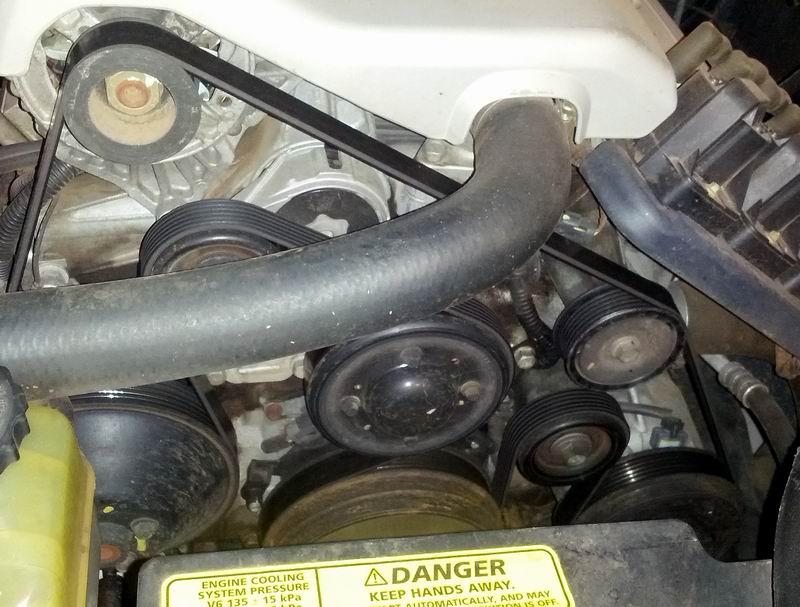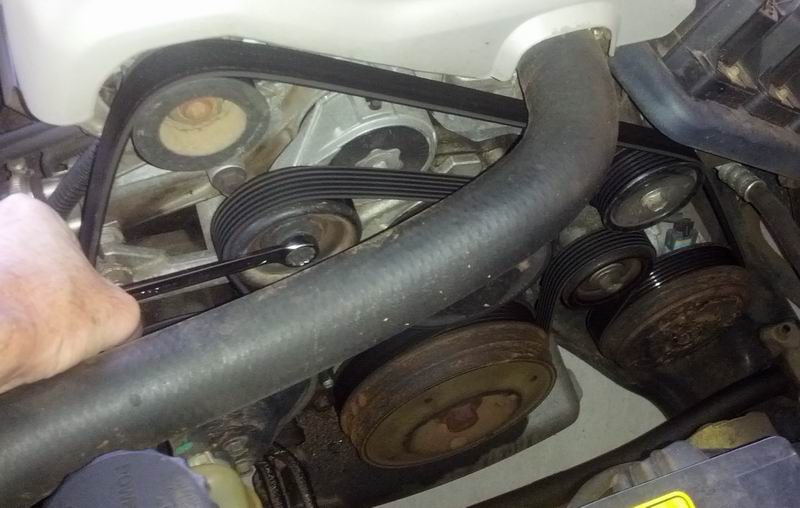I think the designers of the "Serpentine Belt" should be proud of themselves.
What's a Serpentine Belt? I'm glad you asked. Remember the days when your engine would have a v-belt from the crank to the alternator, then another from the crank to the power steering, then another to the water pump, then another to the air conditioning... and remember when you had to change the last one you had to take all the others off...and that they would squeak really easily if you hadn't adjusted the tension...and...
Well some bright spark decided they could make a single belt spin all those peripherals. And, they made it wide with multiple "v"s, and self tensioning, and super strong, and, well, I've just gotta say thanks. There's some guys who were thinking about how to improve an engine.
Okay, sure, if you snap it you lose everything - but that sure is a tough belt, I'm still on the original with no signs of cracking or wear. However, one day, there was quite a whine starting to happen in the engine bay.
I ignored it for a while, but eventually I had to do something about it. The whine changed with engine revs (as most whines do) so I popped the bonnet and looked at that big spaghetti rubber band. One of those things it is linking together is making a noise...
Well it sounded like it was coming from everywhere. No fear:
Step 1, water spray bottle. Spray a bit of water on each bearing point along the belt. My idea is that a bit of water will change the sound of the whine, so when I reached the problem I would notice. I didn't notice.
Step 2. Long screwdriver stethoscope. Concept - press a long screwdriver at a point and put your ear against the blunt end, and listen. The idea is that the sound is transferred up the screwdriver to make it easier to hear specific sounds at a point when there are a lot of sounds. It works really well, give it a try, you'd be surprised. I now had my suspicions on one of the idlers, but I wasn't completely sure.
Step 3. A length of wood, pressed against the moving wheel/bearing. Okay, this is a bit dangerous, obviously you don't want to have the length of wood catching in a moving part. However, when I pressed against the idler that I was suspicious of, sure enough, the extra side-pressure on the bearing made a very clear change in whine. Okay, there is definitely a problem with the bearing in that particular idler.
Well a tiny bit of disappointment - when I went to the shop you can't just buy a new $5 bearing and press it in, the whole idler pulley is throw away. It is plastic though, so it's not really designed to last forever. For $40 I got a nice new shiny metal pulley. Well, it's still cheaper than paying someone else to do it.
But, the disappointment of the expense is very short lived - to take the belt off, you simply "unwind" the tensioner bolt. It is a left handed thread, so lefty-loosey you are in fact tightening the bolt, but more importantly, you are pushing back against the spring of the tensioner. Yep the belt is held in place by a spring, how easy is that! You'd hope that the tensioner assembly is designed so that it doesn't "lock up" with dirt and grime, well, it didn't seem to. And there was still tension available, meaning that the belt hadn't stretched so far that there was no more spring left. By the way, if that happens, you'll start to hear the belt slip and you'll know it is time to change the belt. If you can see cracking and crazing in the belt, it is time to change the belt.
So "undo" the tensioner bolt to hold back the tension, slip the belt over the alternator, how good is that?! Another bolt holds the whole idler in place - normal right handed thread - pop the new one on, push against the tension against and put the belt back in place. Look at each belt contact point to make sure the grooves are lined up with the belt. Let the tension back on - done, how easy was that?!
Start engine, marvel at how quiet it is, and marvel that we have come far enough in belt and pulley "technology" that this job was so easy.
JAW












 database
database